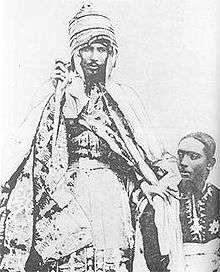Ethiopian–Egyptian War
| Ethio-Egyptian War | |||||||
|---|---|---|---|---|---|---|---|
 Yohannes IV of Ethiopia and Isma'il Pasha of Egypt. | |||||||
| |||||||
| Belligerents | |||||||
|
|
| ||||||
| Commanders and leaders | |||||||
|
|
| ||||||
| Strength | |||||||
| 9,500[2] – 30,000+[3] | 50,000[3] – 60,000[2] | ||||||
| Casualties and losses | |||||||
| 2,000+[4] | ? | ||||||
The Ethiopian-Egyptian War was a war between the Ethiopian Empire and the Khedivate of Egypt from 1874 to 1876, resulting in an Ethiopian victory.
Background
Egypt under the rule of the Ottoman Empire, led by Isma'il Pasha, the Khedive of Egypt, sought to expand his reign to the land of Abyssinia and control the Blue Nile. Isma'il Pasha became the ruler of Egypt in 1863. After annexing Darfur in 1875, he turned his attention to Ethiopia. He wished to create an empire covering the whole of the Nile River, much of which is in Ethiopia, and to do this he built a large army, recruiting many European and American officers. Yohannes IV became the emperor of Ethiopia in 1872 after defeating Tekle Giyorgis II in battle. He worked on modernizing his army, some of whom were trained by the British adventurer John Kirkham.
Fighting
The Egyptians invaded from their coastal possessions in what is now Eritrea. The armies of Yohannes and Isma'il met at Gundet on the morning of 16 November 1875. Not only were the Egyptians vastly outnumbered, they were also taken completely by surprise as they were marching through a narrow mountain pass. The mass of Ethiopian warriors sallied forth from their hiding places up the slope and swiftly charged down upon the shocked Egyptian columns, nullifying the latter's advantage in firepower and causing many of the unenthusiastic fellahin soldiers to rout. The Egyptian forces were completely destroyed. News of this huge defeat was suppressed in Egypt for fear that it would undermine the government of the Khedive. The Egyptians tried again to invade from the north but were again defeated at the Battle of Gura in March 1876.
Aftermath
Ethiopia and Egypt remained in a state of tension, which largely abated after the 1884 Hewett Treaty.
European involvement
Several foreigners were involved in the war. These include a British adventurer John Kirkham on the Ethiopian side, and Adolf Arendrup as well as a Swiss explorer Werner Munzinger on the Egyptian side. Munzinger led one of the Egyptian attacks against Ethiopia, marching inland from Tadjoura, but his troops were overwhelmed by the army of Mahammad ibn Hanfadhe, Sultan of Aussa, and he was killed in battle.[1]
See also
References
- 1 2 Edward Ullendorff, The Ethiopians: An Introduction to Country and People, second edition (London: Oxford University Press, 1965), p. 90. ISBN 0-19-285061-X.
- 1 2 "The Ethiopian-Egyptian War: 1874–1876". Retrieved 2016-12-21.
- 1 2 http://www.historynet.com/first-italo-abyssinian-war-battle-of-adowa.htm
- ↑ Jesman, Czeslaw (January 1959). "Egyptian Invasion of Ethiopia". African Affairs. Oxford University Press. 58 (230): 75–81. JSTOR 718057.